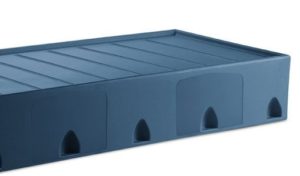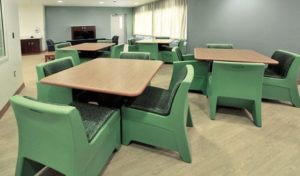Increase in Keeping Behavioral Healthcare Facilities Safer on the Horizon, Publication Says
A leading publication that provides business and legal information to healthcare professionals recently listed five top predictions for facility design in 2017, one of which sees this as the year that psychiatric facilities put more emphasis on innovative processes that can keep patients safer.
In a December article, Becker’s Hospital Review listed these forecasts which were provided by E4H, an architecture firm that works within the healthcare industry. In regards to behavioral health, E4H states:
“An increasingly acute patient population entering inpatient psychiatric facilities and a growing emphasis on mitigating risk of patient and employee harm has spurred existing facilities to pursue upgrades to become safer for patients and staff.”
One of the most interesting safety features for behavioral health that is mentioned is the “securing of furniture to walls and floors,” a safeguard that is necessary in environments where patients often can become unstable and use chairs as a weapon. In other cases, patients use the space between beds and walls as a place to hide contraband.
Norix Furniture is a leading provider of behavioral healthcare furniture, nearly all of which can easily be secured in facilities for increased safety. Three methods of securing our furniture to walls and floors include:
 Bolting – Bolting down furniture is considered the most effective measure in securing your furniture in intensive-use environments. This method – which is performed exactly how it sounds – uses highly durable bolts to fasten products to the floor for maximum security. Bolting down furniture ensures that the product is not going anywhere and will not be used as a barricade or a blocking mechanism against doors or specific areas in your facility. On Norix Furniture Attenda beds, holes at the base of the product allow facilities to bolt the beds directly into the floor, including concrete. This can create a secure and snug fit against a wall or in the corner of a room.
Bolting – Bolting down furniture is considered the most effective measure in securing your furniture in intensive-use environments. This method – which is performed exactly how it sounds – uses highly durable bolts to fasten products to the floor for maximum security. Bolting down furniture ensures that the product is not going anywhere and will not be used as a barricade or a blocking mechanism against doors or specific areas in your facility. On Norix Furniture Attenda beds, holes at the base of the product allow facilities to bolt the beds directly into the floor, including concrete. This can create a secure and snug fit against a wall or in the corner of a room.
 Ganging – This is the process of connecting chairs together using – most often – metal plates or other hardware on the backside or underneath the furniture piece. For example, our Forté™ chairs have molded-in steel threaded inserts so that our ganging hardware can be inserted on the bottom of the chair, allowing the furniture to be fastened together. This method of securing chairs ensures that the product will not be picked up and used as a weapon, and allows facilities to remove and re-insert the hardware if they wish to reconfigure the chairs in the future. Also, if there aren’t too many chairs ganged together, staff members can move the chairs for cleaning and maintenance.
Ganging – This is the process of connecting chairs together using – most often – metal plates or other hardware on the backside or underneath the furniture piece. For example, our Forté™ chairs have molded-in steel threaded inserts so that our ganging hardware can be inserted on the bottom of the chair, allowing the furniture to be fastened together. This method of securing chairs ensures that the product will not be picked up and used as a weapon, and allows facilities to remove and re-insert the hardware if they wish to reconfigure the chairs in the future. Also, if there aren’t too many chairs ganged together, staff members can move the chairs for cleaning and maintenance.
 Ballasting – Ballasting is the act of filling your furniture (usually a chair) with some kind of material to weigh the piece down and limit movement. Most often this material is dry sand, and in many cases – depending upon the size of the cavity of the chair – significant weight can be added, therefore limiting movement and ensuring that the chair cannot be thrown or used as a weapon. For example, our Forté guest chairs come with molded-in access ports with a threaded screw cap on the bottom of the chair where sand can be inserted. And while the chairs become significantly heavier, a small team of staff members working together can move the furniture when a new configuration is needed or if the areas around or underneath the chair need to be cleaned.
Ballasting – Ballasting is the act of filling your furniture (usually a chair) with some kind of material to weigh the piece down and limit movement. Most often this material is dry sand, and in many cases – depending upon the size of the cavity of the chair – significant weight can be added, therefore limiting movement and ensuring that the chair cannot be thrown or used as a weapon. For example, our Forté guest chairs come with molded-in access ports with a threaded screw cap on the bottom of the chair where sand can be inserted. And while the chairs become significantly heavier, a small team of staff members working together can move the furniture when a new configuration is needed or if the areas around or underneath the chair need to be cleaned.
Other predictions listed in the article include an increase in microhospitals; the modernization of the emergency department; greater infection control; and more medical villages, a concept where a large family medical practice is surrounded by several specialists in an attempt to improve patient outcomes.
Click here for more information on Norix Furniture’s behavioral healthcare furniture solutions.